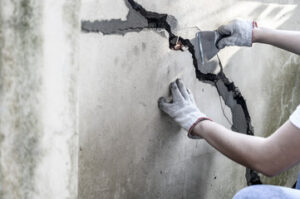There are several ways to repair cracked and damaged concrete. The first method is to dampen the area. This may be done by using a plastic or burlap sheet. The repair process requires time and patience as new concrete develops on the old concrete slowly. The longer the moist curing period, the less likely the new concrete will shrink and loosen. Then, the repaired area should be exposed to heat to harden the new concrete. This process is best performed by a professional. 
For surface defects, sand or chipping can be used to remove the loose stone. Sawing is an option for small areas. For larger areas, blowing and brushing are also methods. Some repair materials are toxic, odorous, or combustible. To minimize downtime, choose materials with a quick set time. In addition, choose materials that can withstand heavy vehicular traffic. In addition, consider the deterioration of the concrete in your area.
For cracks, you may want to have your concrete repaired. Not only is it cosmetically appealing, but cracks can also lead to costly repairs. Cracked concrete will only get worse with time. It is also more prone to damage from chemicals, freeze-thaw cycles, and moisture. Concrete repair services can inspect the concrete surface for these problems and make recommendations that are appropriate for your situation. If you suspect cracks, you should have a professional perform the repair.
Another method to repair cracked concrete is to inject epoxy into the cracks. The epoxy resin is designed to reduce corrosion by providing a barrier between the steel and the concrete. Depending on the severity of the corrosion, shoring may be necessary to stabilize the structure. Concrete repair is only successful if the preparation is thorough. You must remove any corroded reinforcing bars or steel reinforcement that are embedded in the concrete. If possible, you must clean and disinfect the steel before tying it to the new concrete.
Despite the many benefits of concrete, it does have one major weakness. However, you can repair concrete structures that are still structurally sound and in a sound state. The key is to use the right repair product for the specific type of damage that you have. There are many different types of repair materials. Find the best one for your concrete. You may even be able to do it yourself, saving money in the process. Then, apply the patch. The process will restore your concrete to like-new condition.
Once the concrete is prepared, it is time to apply the patch. It can be applied by trowel. Be careful not to block the expansion joints, as this will prevent the concrete from cracking further. Concrete patching is also a good option for small cracks. The concrete patch can harden within minutes, while thicker patches may take a few hours. If you don’t want to pay someone to fix your concrete, you can simply do it yourself.
A physical cause of concrete damage can come from heat, moisture, wind, and temperature changes. Physical deterioration results from changes in concrete’s mass, which increases the material’s permeability. Other causes of concrete damage can include the leaching of cement paste. These cracks can also be cosmetic but are not structural. They offer free inspections and a dependable warranty.
A permanent solution for concrete repair requires an injection foam lift that targets the root cause of the problem. Injection foam lifting is used to fix concrete slabs. You can also get a free slab inspection in some companies. If you are unsure of whether your concrete slab needs repair, ask your local dealer.
Before applying concrete repair products, you need to understand how to select the right material for your project. You can buy ready-to-use materials, but you will need to apply them to the concrete with a trowel or a squeegee. For exterior applications, a non-slip broom finish is recommended. You can also purchase concrete repair materials that are specially made for precast concrete. You should also ask the supplier to use materials approved by your state’s Department of Transportation.
